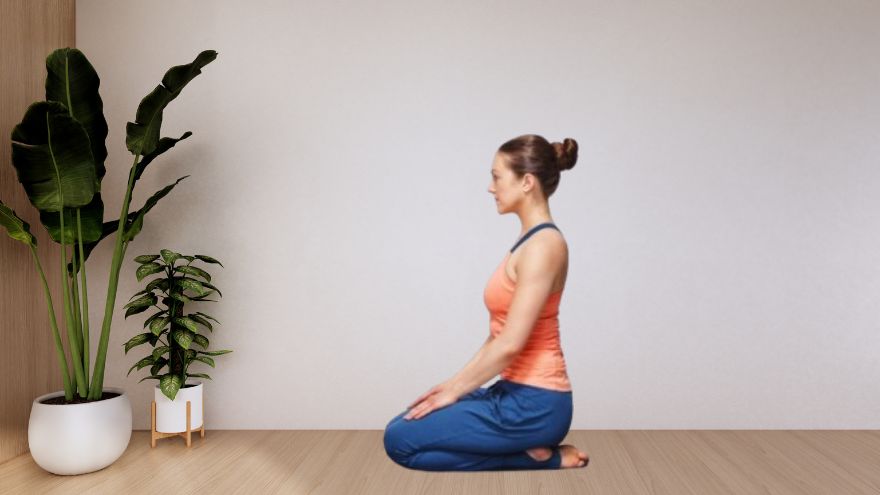
Vajrasana is one of the simplest yet most powerful yoga postures, revered for its many physical and mental benefits. It is a seated pose that is often performed after meals to aid digestion, promote mental clarity, and calm the mind. Known as the "Thunderbolt Pose" or "Diamond Pose," vajrasana has a special place in yoga practice due to its accessibility and its profound impact on overall well-being.
What is Vajrasana?
“Vajrasana” is derived from the Sanskrit word “Vajra,” meaning thunderbolt or diamond, and “Asana,” meaning pose or posture. In traditional yoga, it is believed that practicing this asana can make the body strong and stable like a thunderbolt. It is a kneeling posture where the practitioner sits back on the heels with the toes touching, knees together, and palms resting on the thighs.
Unlike many other yoga poses, vajrasana can be practiced immediately after eating, which is why it’s often recommended for improving digestion. This simple sitting pose can be practiced by anyone regardless of fitness level, making it an essential part of yoga routines.
How to Do Vajrasana
The simplicity of vajrasana often belies its effectiveness. Here are the steps to perform vajrasana correctly:
1. Start by kneeling on the floor, keeping your legs together.
2. Bring your big toes together and let your heels separate.
3. Slowly sit back on your heels, making sure your weight is evenly distributed.
4. Place your palms on your thighs, fingers pointing downward.
5. Sit upright with your back straight and look forward, keeping your head aligned with your spine.
6. Relax your shoulders and focus on your breathing.
7. Hold the pose for 5–10 minutes, gradually increasing the duration with practice.
When to Do Vajrasana
One of the unique aspects of vajrasana is that it can be done at any time. However, it is most beneficial when practiced:
- After meals: It aids digestion and relieves bloating and discomfort.
- During meditation: It promotes concentration and calmness.
- As part of a yoga routine: It is often used in conjunction with breathing exercises or other meditative postures.
Vajrasana Benefits
Vajrasana is often underrated for its physical and mental benefits. Here’s a breakdown of how this simple pose can positively impact your health:
1. Improves Digestion: One of the most widely recognized benefits of vajrasana is its ability to aid digestion. By sitting in this pose after meals, the posture helps regulate blood flow to the stomach, enhancing the digestive process and alleviating problems like acidity and bloating.
2. Strengthens Lower Back and Legs: Vajrasana helps improve the flexibility of the thighs, legs, and lower back. It strengthens muscles and bones, providing stability and improving posture over time.
3. Promotes Mental Calmness: This posture is known to calm the nervous system. It helps alleviate stress, anxiety, and mild depression. When combined with deep breathing or meditation, vajrasana enhances mental focus and clarity.
4. Relieves Constipation: By enhancing blood flow and stimulating the intestines, vajrasana helps in easing constipation and other digestive issues.
5. Helps in Weight Loss: Though not directly a calorie-burning pose, vajrasana can help with digestion and metabolism, indirectly aiding in weight management.
Types of Vajrasana
Though the basic Vajrasana posture remains the same, variations of this pose offer additional benefits:
1. Supta Vajrasana (Reclined Thunderbolt Pose):
In this variation, after sitting in Vajrasana, you gently lean backward and rest your upper body on the floor while your knees remain bent. It intensifies the stretch and targets the abdomen and chest muscles.
2. Sasangasana (Rabbit Pose):
This posture starts in Vajrasana but then shifts to a forward fold where you bring your forehead to the floor and hold your heels. It helps stretch the spine and relaxes the mind.
Contraindications of Vajrasana
Despite its many benefits, there are a few situations where vajrasana may not be suitable:
- Knee or ankle injuries: Since the pose puts pressure on the knees and ankles, individuals with injuries in these areas should avoid it or practice with modifications.
- Severe joint pain: People with arthritis or severe joint issues should consult a doctor or yoga instructor before practicing vajrasana.
- Pregnancy: While some may wonder, "Can we sit in vajrasana during pregnancy?" it’s generally advised to avoid vajrasana, especially in the later stages of pregnancy, as it can restrict blood flow to the legs and increase discomfort.
Disadvantages of Vajrasana
While vajrasana is safe and beneficial for most people, there are a few disadvantages of vajrasana if practiced incorrectly or without proper attention to the body’s needs:
1. Knee Pain: People with sensitive knees or joint problems may experience discomfort.
2. Ankle Strain: Sitting in vajrasana for too long may strain the ankles.
3. Numbness in the legs: Sitting for extended periods can sometimes cause numbness or tingling due to restricted blood flow.
If you experience any discomfort or pain while practicing vajrasana, it’s advisable to stop and consult a professional yoga instructor.
Conclusion
Vajrasana is a versatile yoga posture that offers numerous benefits for both physical and mental health. Whether you’re looking to improve digestion, calm your mind, or enhance your flexibility, vajrasana can be a valuable addition to your daily routine. Always remember to practice mindfully, and consult a professional if you experience any discomfort or have health concerns.
Related FAQs
Q. What are the benefits of vajrasana?
Ans. Vajrasana improves digestion, enhances mental clarity, strengthens the lower back and legs, and promotes relaxation. It also helps in reducing bloating and constipation.
Q. Can we sit in vajrasana during pregnancy?
Ans. It is best to avoid vajrasana during pregnancy, especially in the later stages, due to the increased pressure on the abdomen and restricted blood circulation to the legs.
Q. How does vajrasana help in digestion?
Ans. Vajrasana improves blood flow to the stomach, aiding the digestive process and reducing issues like acidity, gas, and indigestion.
Q. When is the best time to practice vajrasana?
Ans. Vajrasana can be practiced at any time, but it is especially effective after meals and during meditation.
Q. Can we do vajrasana during periods?
Ans. Yes, vajrasana is a gentle pose that can be practiced during menstruation. It helps relax the body and may ease menstrual discomfort. However, every body is different, and it is best to listen to your body and avoid discomfort.
Q. Can Vajrasana be done after meals?
Ans. Yes, unlike many other yoga postures, Vajrasana can and should be done after meals to improve digestion.
Q. How long should you sit in Vajrasana?
Ans. Beginners can start by sitting in Vajrasana for 2-5 minutes and gradually increase the time to 15-20 minutes.



